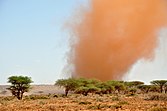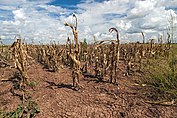Drought
Adroughtis a period of drier-than-normal conditions.[1]: 1157 A drought can last for days, months or years. Drought often has large impacts on theecosystemsandagricultureof affected regions, and causes harm to the localeconomy.[2][3]Annual dry seasons in thetropicssignificantly increase the chances of a drought developing, with subsequent increasedwildfirerisks.[4]Heat wavescan significantly worsen drought conditions by increasingevapotranspiration.[5]This dries out forests and other vegetation, and increases the amount of fuel for wildfires.[4][6]
Drought is a recurring feature of the climate in most parts of the world, becoming more extreme and less predictable due toclimate change,whichdendrochronologicalstudies date back to 1900. There are three kinds of drought effects, environmental, economic and social. Environmental effects include the drying ofwetlands,more and larger wildfires,loss of biodiversity.
Economic impacts include disruption ofwater suppliesfor people, less agricultural productivity and therefore more expensive food production. Another impact is shortages of water forirrigationorhydropower.Social and health costs include the negative effect on the health of people directly exposed to this phenomenon (excessive heat waves), high food costs, stress caused by failed harvests,water scarcity,etc. Prolonged droughts have causedmass migrationsandhumanitarian crisis.[7][8]
Examples for regions with increased drought risks are theAmazon basin,Australia,theSahelregion andIndia.For example, in 2005, parts of theAmazon basinexperienced the worst drought in 100 years.[9][10]Australia could experience more severe droughts and they could become more frequent in the future, a government-commissioned report said on July 6, 2008.[11]The long AustralianMillennial droughtbroke in 2010. The2020–2022 Horn of Africa droughthas surpassed the horrific drought in 2010–2011 in both duration and severity.[12][13]More than 150 districts in India are drought vulnerable, mostly concentrated in the state of Rajasthan, Gujarat, Madhya Pradesh and its adjoining Chhattisgarh, Uttar Pradesh, northern Karnataka and adjoining Maharashtra of the country.[14]
Throughout history, humans have usually viewed droughts asdisastersdue to the impact on food availability and the rest of society. People have viewed drought as anatural disasteror as something influenced byhuman activity,or as a result ofsupernaturalforces.
Definition

TheIPCC Sixth Assessment Reportdefines a drought simply as "drier than normal conditions".[1]: 1157 This means that a drought is "a moisture deficit relative to the average water availability at a given location and season".[1]: 1157
According toNational Integrated Drought Information System,a multi-agency partnership, drought is generally defined as "a deficiency of precipitation over an extended period of time (usually a season or more), resulting in a water shortage". The National Weather Service office of theNOAAdefines drought as "a deficiency of moisture that results in adverse impacts on people, animals, or vegetation over a sizeable area".[15]
Drought is a complex phenomenon − relating to the absence of water − which is difficult to monitor and define.[16]By the early 1980s, over 150 definitions of "drought" had already been published.[17]The range of definitions reflects differences in regions, needs, and disciplinary approaches.
Categories
There are three major categories of drought based on where in the water cycle the moisture deficit occurs: meteorological drought, hydrological drought, and agricultural or ecological drought.[1]: 1157 A meteorological drought occurs due to lack ofprecipitation.A hydrological drought is related to low runoff, streamflow, and reservoir storage. An agricultural or ecological drought is causing plant stress from a combination of evaporation and lowsoil moisture.[1]: 1157 Some organizations add another category: socioeconomic drought occurs when the demand for an economic good exceeds supply as a result of a weather-related shortfall in water supply.[16][17]The socioeconomic drought is a similar concept towater scarcity.
The different categories of droughts have different causes but similar effects:
- Meteorologicaldrought occurs when there is a prolonged time with less than average precipitation.[18]Meteorological drought usually precedes the other kinds of drought.[19]As a drought persists, the conditions surrounding it gradually worsen and its impact on the local population gradually increases.
- Hydrologicaldrought is brought about when the water reserves available in sources such asaquifers,lakesandreservoirsfall below alocally significantthreshold. Hydrological drought tends to show up more slowly because it involves stored water that is used but not replenished. Like an agricultural drought, this can be triggered by more than just a loss of rainfall. For instance, around 2007Kazakhstanwas awarded a large amount of money by theWorld Bankto restore water that had been diverted to other nations from theAral SeaunderSovietrule.[20]Similar circumstances also place their largest lake,Balkhash,at risk of completely drying out.[21]
- Agriculturalor ecological droughts affect crop production orecosystemsin general. This condition can also arise independently from any change in precipitation levels when either increasedirrigationorsoilconditions and erosion triggered by poorly planned agricultural endeavors cause a shortfall in water available to the crops.
Indices and monitoring
Several indices have been defined to quantify and monitor drought at different spatial and temporal scales. A key property of drought indices is their spatial comparability, and they must be statistically robust.[22]Drought indices include:[22]
- Palmer drought index(sometimes called the Palmer drought severity index (PDSI)): a regional drought index commonly used for monitoring drought events and studying areal extent and severity of drought episodes.[23]The index uses precipitation and temperature data to study moisture supply and demand using a simple water balance model.[23][24][25]
- Keetch-Byram Drought Index:an index that is calculated based on rainfall, air temperature, and othermeteorologicalfactors.[26]
- Standardized precipitation index (SPI): It is computed based on precipitation, which makes it a simple and easy-to-apply indicator for monitoring and prediction of droughts in different parts of the world. TheWorld Meteorological Organizationrecommends this index for identifying and monitoring meteorological droughts in different climates and time periods.[22]
- Standardized Precipitation Evapotranspiration Index(SPEI): a multiscalar drought index based on climatic data. The SPEI accounts also for the role of the increased atmosphericevaporative demandon drought severity.[22]Evaporative demand is particularly dominant during periods of precipitation deficit. The SPEI calculation requires long-term and high-quality precipitation and atmospheric evaporative demand datasets. These can be obtained from ground stations or gridded data based on reanalysis as well as satellite and multi-source datasets.[22]
- Indices related to vegetation: root-zone soil moisture, vegetation condition index (VDI) and vegetation health index (VHI). The VCI and VHI are computed based on vegetation indices such as the normalized difference vegetation index (NDVI) and temperature datasets.[22]
- Deciles index
- Standardized runoff index
High-resolution drought information helps to better assess the spatial and temporal changes and variability in drought duration, severity, and magnitude at a much finer scale. This supports the development of site-specific adaptation measures.[22]
The application of multiple indices using different datasets helps to better manage and monitor droughts than using a single dataset, This is particularly the case in regions of the world where not enough data is available such as Africa and South America. Using a single dataset can be limiting, as it may not capture the full spectrum of drought characteristics and impacts.[22]
Careful monitoring of moisture levels can also help predict increased risk for wildfires.
Causes
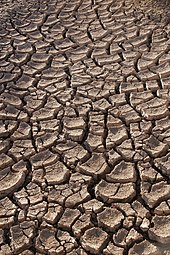
General precipitation deficiency
Mechanisms of producing precipitation includeconvective,stratiform,[27]andorographicrainfall.[28]Convective processes involve strong vertical motions that can cause the overturning of the atmosphere in that location within an hour and cause heavy precipitation,[29]while stratiform processes involve weaker upward motions and less intense precipitation over a longer duration.[30]
Precipitation can be divided into three categories, based on whether it falls as liquid water, liquid water that freezes on contact with the surface, or ice.
Droughts occur mainly in areas where normal levels of rainfall are, in themselves, low. If these factors do not support precipitation volumes sufficiently to reach the surface over a sufficient time, the result is a drought. Drought can be triggered by a high level of reflected sunlight and above average prevalence of highpressure systems,windscarrying continental, rather than oceanic air masses, and ridges ofhigh pressure areasaloft can prevent or restrict the developing of thunderstorm activity or rainfall over one certain region. Once a region is within drought, feedback mechanisms such as local arid air,[31]hot conditions which can promote warm core ridging,[32]and minimal evapotranspiration can worsen drought conditions.
Dry season
Within the tropics, distinct,wetand dryseasonsemerge due to the movement of theIntertropical Convergence ZoneorMonsoon trough.[33]The dry season greatly increases drought occurrence,[34]and is characterized by its low humidity, with watering holes and rivers drying up. Because of the lack of these watering holes, many grazing animals are forced to migrate due to the lack of water in search of more fertile lands. Examples of such animals arezebras,elephants,andwildebeest.Because of the lack of water in the plants, bushfires are common.[35]Since water vapor becomes more energetic with increasing temperature, more water vapor is required to increase relative humidity values to 100% at higher temperatures (or to get the temperature to fall to the dew point).[36]Periods of warmth quicken the pace of fruit and vegetable production,[37]increase evaporation and transpiration from plants,[38]and worsen drought conditions.[39]
El Niño–Southern Oscillation (ENSO)
TheEl Niño–Southern Oscillation(ENSO) phenomenon can sometimes play a significant role in drought. ENSO comprises two patterns of temperature anomalies in the centralPacific Ocean,known asLa NiñaandEl Niño.La Niña events are generally associated with drier and hotter conditions and further exacerbation of drought inCaliforniaand theSouthwestern United States,and to some extent theU.S. Southeast.Meteorological scientists have observed that La Niñas have become more frequent over time.[40]
Conversely, during El Niño events, drier and hotter weather occurs in parts of theAmazon RiverBasin,Colombia,andCentral America.Winters during the El Niño are warmer and drier than average conditions in the Northwest, northern Midwest, and northern Mideast United States, so those regions experience reduced snowfalls. Conditions are also drier than normal from December to February in south-central Africa, mainly inZambia,Zimbabwe,Mozambique,andBotswana.Direct effects of El Niño resulting in drier conditions occur in parts ofSoutheast AsiaandNorthern Australia,increasingbush fires,worseninghaze,and decreasing air quality dramatically. Drier-than-normal conditions are also in general observed inQueensland,inlandVictoria,inlandNew South Wales,and easternTasmaniafrom June to August. As warm water spreads from the west Pacific and theIndian Oceanto the east Pacific, it causes extensive drought in the western Pacific. Singapore experienced the driest February in 2014 since records began in 1869, with only 6.3 mm of rain falling in the month and temperatures hitting as high as 35 °C on 26 February. The years 1968 and 2005 had the next driest Februaries, when 8.4 mm of rain fell.[41]
Climate change

Globally, the occurrence of droughts has increased as a result of theincrease in temperatureand atmosphericevaporative demand.In addition, increasedclimate variabilityhas increased the frequency and severity of drought events. Moreover, the occurrence and impact of droughts are aggravated by anthropogenic activities such as land use change and water management and demand.[22]
TheIPCC Sixth Assessment Reportalso pointed out that "Warming over land drives an increase in atmospheric evaporative demand and in the severity of drought events"[43]: 1057 and "Increased atmospheric evaporative demand increases plant water stress, leading to agricultural and ecological drought".[44]: 578
There is a rise of compound warm-season droughts in Europe that are concurrent with an increase in potentialevapotranspiration.[45]
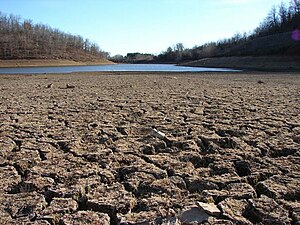
Higher temperatures increase evaporation. This dries the soil and increasesplant stress.Agriculture suffers as a result. This means even regions where overall rainfall is expected to remain relatively stable will experience these impacts.[48]: 1157 These regions include central and northern Europe. Without climate change mitigation, around one third of land areas are likely to experience moderate or more severe drought by 2100.[48]: 1157 Due to global warming droughts are more frequent and intense than in the past.[49]
Several impacts make their impacts worse. These are increased water demand, population growth and urban expansion in many areas.[50]Land restorationcan help reduce the impact of droughts. One example of this isagroforestry.[51]Erosion and human activities
Human activity can directly trigger exacerbating factors such as over-farming, excessiveirrigation,[52]deforestation,anderosionadversely impact the ability of the land to capture and hold water.[53]In arid climates, the main source of erosion is wind.[54]Erosion can be the result of material movement by the wind. The wind can cause small particles to be lifted and therefore moved to another region (deflation). Suspended particles within the wind may impact on solid objects causing erosion by abrasion (ecological succession). Wind erosion generally occurs in areas with little or no vegetation, often in areas where there is insufficient rainfall to support vegetation.[55]
Impacts



Drought is one of the most complex and majornatural hazards,and it has devastating impacts on the environment, economy, water resources, agriculture, and society worldwide.[22]
One can divide the impacts of droughts and water shortages into three groups: environmental, economic and social (including health).
Environmental and economic impacts
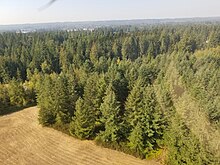
Environmental effects of droughts include: lower surface and subterranean water-levels, lower flow-levels (with a decrease below the minimum leading to direct danger for amphibian life), increasedpollution of surface water,the drying out ofwetlands,more and largerwildfires,higher deflation intensity,loss of biodiversity,worse health of trees and the appearance of pests and dendroid diseases.[56][6]
Economic losses as a result of droughts include lower agricultural, forests, game and fishing output, higher food-production costs, lower energy-production levels in hydro plants, losses caused by depleted water tourism and transport revenue, problems with water supply for theenergy sectorand for technological processes in metallurgy, mining, the chemical, paper, wood, foodstuff industries etc., disruption ofwater suppliesfor municipal economies.
Further examples of common environmental and economic consequences of drought include:
- Alteration ofdiversity of plant communities,which can have an impact on netprimary productionand otherecosystem services.[57]
- Wildfires,such asAustralian bushfiresandwildfires in the United States,become more common during times of drought and may cause human deaths.[58]
- Dust Bowls,themselves a sign oferosion,which further erode thelandscape
- Dust storms,when drought hits an area suffering from desertification anderosion
- Habitatdamage, affecting bothterrestrialandaquaticwildlife[59]
- Snakemigration, which results in snake-bites[60]
- Reducedelectricity productiondue to reduced water-flow throughhydroelectricdams[61]
- Shortages of water forindustrialusers[62][63]
Agricultural impacts

Droughts can cause land degradation and loss of soil moisture, resulting in the destruction of cropland productivity.[64]This can result in diminishedcrop growth or yield productionsandcarrying capacityforlivestock.Drought in combination with high levels of grazing pressure can function as the tipping point for an ecosystem, causingwoody encroachment.[65]
Water stress affects plant development and quality in a variety of ways: firstly drought can cause poor germination and impaired seedling development.[66]At the same time plant growth relies on cellular division, cell enlargement, and differentiation. Drought stress impairsmitosisand cell elongation via loss ofturgor pressurewhich results in poor growth.[67]Development of leaves is also dependent upon turgor pressure, concentration of nutrients, and carbon assimilates[clarification needed]all of which are reduced by drought conditions, thus drought stress lead to a decrease in leaf size and number.[67]Plant height, biomass, leaf size and stem girth has been shown to decrease in maize under water limiting conditions.[67]Crop yield is also negatively effected by drought stress, the reduction in crop yield results from a decrease in photosynthetic rate, changes in leaf development, and altered allocation of resources all due to drought stress.[67]Crop plants exposed to drought stress suffer from reductions in leaf water potential and transpiration rate.Water-use efficiencyincreases in crops such as wheat while decreasing in others, such as potatoes.[68][69][67]
Plants need water for the uptake of nutrients from the soil, and for the transport of nutrients throughout the plant: drought conditions limit these functions leading to stunted growth. Drought stress also causes a decrease in photosynthetic activity in plants due to the reduction of photosynthetic tissues, stomatal closure, and reduced performance of photosynthetic machinery. This reduction in photosynthetic activity contributes to the reduction in plant growth and yields.[67]Another factor influencing reduced plant growth and yields include the allocation of resources; following drought stress plants will allocate more resources to roots to aid in water uptake increasing root growth and reducing the growth of other plant parts while decreasing yields.[67]
Social and health impacts
The most negative impacts of drought for humans includecrop failure,food crisis,famine, malnutrition, andpoverty,which lead to loss of life andmass migrationof people.[22]
There are negative effects on the health of people who are directly exposed to this phenomenon (excessiveheat waves). Droughts can also cause limitations of water supplies, increased water pollution levels, high food-costs, stress caused by failed harvests,water scarcity,etc. Reduced water quality can occur because lower water-flows reduce dilution of pollutants and increasecontaminationof remaining water sources.[70][71]
This explains why droughts and water scarcity operate as a factor which increases the gap betweendevelopedanddeveloping countries.[72]
Effects vary according to vulnerability. For example, subsistence farmers are more likely to migrate during drought because they do not have alternative food-sources. Areas with populations that depend on water sources as a major food-source are more vulnerable to famine.

Further examples of social and health consequences include:
- Water scarcity,crop failure,famine[73]andhunger– drought provides too little water to support food crops;malnutrition,dehydrationand related diseases
- Mass migration,resulting ininternal displacementand internationalrefugees
- Socialunrest
- Warover natural resources, including water and food
- Cyanotoxinaccumulation within food chains and water supply (some of which are among the most potent toxins known to science) can cause cancer with low exposure over the long term.[74]High levels ofmicrocystinappeared inSan Francisco Bay Areasalt-water shellfish and fresh-water supplies throughout the state of California in 2016.
Loss of fertile soils
Wind erosionis much more severe in arid areas and during times of drought. For example, in theGreat Plains,it is estimated that soil loss due to wind erosion can be as much as 6100 times greater in drought years than in wet years.[75]
Loessis a homogeneous, typically nonstratified, porous,friable,slightly coherent, often calcareous, fine-grained,silty,pale yellow or buff, windblown (Aeolian)sediment.[76]It generally occurs as a widespread blanket deposit that covers areas of hundreds of square kilometers and tens of meters thick. Loess often stands in either steep or vertical faces.[77]Loess tends to develop into highly rich soils. Under appropriate climatic conditions, areas with loess are among the most agriculturally productive in the world.[78]Loess deposits are geologically unstable by nature, and will erode very readily. Therefore, windbreaks (such as big trees and bushes) are often planted by farmers to reduce the wind erosion of loess.[54]
Regions particularly affected
Amazon basin
In 2005, parts of theAmazon basinexperienced the worst drought in 100 years.[9][10]A 2006 article reported results showing that the forest in its present form could survive only three years of drought.[79][80]Scientists at the BrazilianNational Institute of Amazonian Researchargue in the article that this drought response, coupled with the effects ofdeforestationon regional climate, are pushing the rainforest towards a "tipping point"where it would irreversibly start to die. It concludes that therainforestis on the brink of being turned intosavannaordesert,with catastrophic consequences for the world's climate. According to theWWF,the combination ofclimate changeand deforestation increases the drying effect of dead trees that fuels forest fires.[81]
Australia
The 1997–2009Millennium Droughtin Australia led to a water supply crisis across much of the country. As a result, many desalination plants were built for the first time (see list).
By far the largest part ofAustraliaisdesertor semi-arid lands commonly known as theoutback.A 2005 study by Australian and American researchers investigated the desertification of the interior, and suggested that one explanation was related tohumansettlers who arrived about 50,000 years ago. Regular burning by these settlers could have preventedmonsoonsfrom reaching interior Australia.[82]In June 2008 it became known that an expert panel had warned of long term, maybe irreversible, severe ecological damage for the wholeMurray-Darling basinif it did not receive sufficient water by October 2008.[83]Australia could experience more severe droughts and they could become more frequent in the future, a government-commissioned report said on July 6, 2008.[11]Australian environmentalistTim Flannery,predicted that unless it made drastic changes,PerthinWestern Australiacould become the world's firstghost metropolis,an abandoned city with no more water to sustain its population.[84]The long AustralianMillennial droughtbroke in 2010.
East Africa and Sahel

Recurring droughts leading todesertificationinEast Africahave created grave ecological catastrophes, prompting food shortages in1984–85,2006and2011.[87]During the 2011 drought, an estimated 50,000 to 150,000 people were reported to have died,[88]though these figures and the extent of the crisis are disputed.[89]In February 2012, the UN announced that the crisis was over due to a scaling up of relief efforts and a bumper harvest.[90]Aid agencies subsequently shifted their emphasis to recovery efforts, including digging irrigation canals and distributing plant seeds.[90]The 2020–2022 Horn of Africa drought has surpassed the horrific drought in 2010–2011 in both duration and severity.[12][13]The Darfur conflict inSudan,also affectingChad,was fueled by decades of drought; combination of drought,desertificationandoverpopulationare among the causes of the Darfur conflict, because theArabBaggaranomadssearching for water have to take their livestock further south, to land mainly occupied by non-Arab farming people.[91]
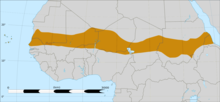
In 2012, a severedroughtstruck the westernSahel.More than 10 million people in the region were at risk of famine due to a month-long heat wave that was hovering overNiger,Mali,MauritaniaandBurkina Faso.[92]
Himalayan river basins

Approximately 2.4 billion people live in thedrainage basinof the Himalayan rivers.[93]India,China,Pakistan,Bangladesh,NepalandMyanmarcould experience floods followed by droughts in coming decades. More than 150 districts in India are drought vulnerable, mostly concentrated in the state of Rajasthan, Gujarat, Madhya Pradesh and its adjoining Chhattisgarh, Uttar Pradesh, northern Karnataka and adjoining Maharashtra of the country.[14]Drought in Indiaaffecting the Ganges is of particular concern, as it providesdrinking waterand agriculturalirrigationfor more than 500 million people.[94][95][96]
North America
The west coast ofNorth America,which gets much of its water fromglaciersin mountain ranges such as theRocky MountainsandSierra Nevada,also would be affected.[97][98]
By country or region
Droughts in particular countries:
See also:
- Droughts and famines in Russia and USSR
- Droughts in California
- 2021 Madagascar food crisis
- 2010 China drought and dust storms
- Cape Town water crisisin 2015–2018
Protection, mitigation and relief

Agriculturally, people can effectively mitigate much of the impact of drought through irrigation andcrop rotation.Failure to develop adequate drought mitigation strategies carries a grave human cost in the modern era, exacerbated byever-increasingpopulation densities.
Strategies for drought protection or mitigation include:
- Dams– many dams and their associated reservoirs supply additional water in times of drought.[99]
- Cloud seeding– a form of intentional weather modification to induce rainfall.[100]This remains a hotly debated topic, as theUnited States National Research Councilreleased a report in 2004 stating that to date, there is still no convincing scientific proof of the efficacy of intentional weather modification.[101]
- Land use – Carefully plannedcrop rotationcan help to minimizeerosionand allow farmers to plant less water-dependent crops in drier years.
- Transvasement– Building canals or redirecting rivers as massive attempts atirrigationin drought-prone areas.
Whenwater is scarcedue to droughts, there are a range of options for people to access other sources of water, such aswastewater reuse,rainwater harvestingandstormwater recovery,or seawaterdesalination.
History
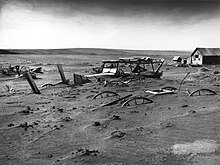
Throughout history, humans have usually viewed droughts asdisastersdue to the impact on food availability and the rest of society. Drought is among the earliest documented climatic events, present in theEpic of Gilgameshand tied to theBiblicalstory ofJoseph's arrival in and the laterExodusfromancient Egypt.[102]Hunter-gatherer migrations in 9,500 BC Chile have been linked to the phenomenon,[103]as has the exodus of early humansout of Africaand into the rest of the world around 135,000 years ago.[104]
Droughts can be scientifically explained in terms of physical mechanisms, which underlienatural disastersand are influenced byhuman impact on the environment.[105] Beliefs about drought are further shaped by cultural factors including local knowledge, perceptions, values, beliefs and religion. In some places and times, droughts have been interpreted as the work ofsupernaturalforces.[106]Globally, people in many societies have been more likely to explain natural events like drought, famine and disease in terms of the supernatural than they are to explain social phenomena like war, murder, and theft.[107][108]
Historically,ritualshave been used in an attempt to prevent or avert drought.Rainmaking ritualshave ranged from dances toscapegoatingtohuman sacrifices.Many ancient practices are now a matter offolklorewhile others may still be practiced.[109]
In areas where people have limited understanding of the scientific basis of drought, beliefs about drought continue to reflect indigenous beliefs in the power of spirits and Christian philosophies that see drought as a divine punishment. Such beliefs can influence people's thinking and affect their resilience and ability to adapt to stress and respond to crises.[106]In the case ofCreationism,curricula sometimes give religious explanations of natural phenomena rather than scientific ones. Teaching explicitly deniesevolution,that human agency is affecting climate, and that climate change is occurring.[110]
Some historical droughts include:
- The longest drought inrecorded historystarted 400 years ago in theAtacama DesertinChileand still continues.[111]
- Drought might have been a contributing factor toClassic Maya collapsebetween the 7th and 9th centuries
- 1540 Central Europe,said to be the "worst drought of the millennium" with eleven months without rain and temperatures of 5–7 °C above the average of the 20th century[112][113]
- 1900 India killing between 250,000 and 3.25 million.
- 1921–22 Soviet Union in which over 5 million perished from starvation due to drought.
- 1928–30 Northwest China resulting in over 3 million deaths by famine.
- 1936 and 1941 Sichuan Province China resulting in 5 million and 2.5 million deaths respectively.
See also
- Aridity index
- Drought refuge
- Flash drought
- Food security
- Leaf Sensor
- List of droughts
- Permanent wilting point
- United Nations Convention to Combat Desertification
- Water security
References
- ^abcdeDouville, H., K. Raghavan, J. Renwick, R.P. Allan, P.A. Arias, M. Barlow, R. Cerezo-Mota, A. Cherchi, T.Y. Gan, J. Gergis, D. Jiang, A. Khan, W. Pokam Mba, D. Rosenfeld, J. Tierney, and O. Zolina, 2021:Water Cycle ChangesArchived2022-09-29 at theWayback Machine.In Climate Change 2021: The Physical Science Basis. Contribution of Working Group I to the Sixth Assessment Report of the Intergovernmental Panel on Climate Change [Masson-Delmotte, V., P. Zhai, A. Pirani, S.L. Connors, C. Péan, S. Berger, N. Caud, Y. Chen, L. Goldfarb, M.I. Gomis, M. Huang, K. Leitzell, E. Lonnoy, J.B.R. Matthews, T.K. Maycock, T. Waterfield, O. Yelekçi, R. Yu, and B. Zhou (eds.)]. Cambridge University Press, Cambridge, United Kingdom and New York, NY, USA, pp. 1055–1210, doi:10.1017/9781009157896.010.
- ^Living With DroughtArchived2007-02-18 at theWayback Machine
- ^Australian Drought and Climate ChangeArchived2018-07-26 at theWayback Machine,retrieved on June 7th 2007.
- ^abBrando, Paulo M.; Paolucci, Lucas; Ummenhofer, Caroline C.; Ordway, Elsa M.; Hartmann, Henrik; Cattau, Megan E.; Rattis, Ludmila; Medjibe, Vincent; Coe, Michael T.; Balch, Jennifer (30 May 2019)."Droughts, Wildfires, and Forest Carbon Cycling: A Pantropical Synthesis".Annual Review of Earth and Planetary Sciences.47(1): 555–581.Bibcode:2019AREPS..47..555B.doi:10.1146/annurev-earth-082517-010235.ISSN0084-6597.
- ^Merzdorf, Jessica (July 9, 2019)."A Drier Future Sets the Stage for More Wildfires".Climate Change: Vital Signs of the Planet.NASA.
- ^abHartmann, Henrik; Bastos, Ana; Das, Adrian J.; Esquivel-Muelbert, Adriane; Hammond, William M.; Martínez-Vilalta, Jordi; McDowell, Nate G.; Powers, Jennifer S.; Pugh, Thomas A.M.; Ruthrof, Katinka X.; Allen, Craig D. (20 May 2022)."Climate Change Risks to Global Forest Health: Emergence of Unexpected Events of Elevated Tree Mortality Worldwide".Annual Review of Plant Biology.73(1): 673–702.doi:10.1146/annurev-arplant-102820-012804.ISSN1543-5008.PMID35231182.
- ^Stanke, C; Kerac, M; Prudhomme, C; Medlock, J; Murray, V (5 June 2013)."Health effects of drought: a systematic review of the evidence".PLOS Currents.5.doi:10.1371/currents.dis.7a2cee9e980f91ad7697b570bcc4b004(inactive 2024-04-30).PMC3682759.PMID23787891.
{{cite journal}}:CS1 maint: DOI inactive as of April 2024 (link) - ^Bellizzi, Saverio; Lane, Chris; Elhakim, Mohamed; Nabeth, Pierre (12 November 2020)."Health consequences of drought in the WHO Eastern Mediterranean Region: hotspot areas and needed actions".Environmental Health.19(1): 114.Bibcode:2020EnvHe..19..114B.doi:10.1186/s12940-020-00665-z.ISSN1476-069X.PMC7659048.PMID33183302.
- ^ab"Amazon Drought Worst in 100 Years".ens-newswire.Archived fromthe originalon 2019-11-15.Retrieved5 November2017.
- ^abDrought Threatens Amazon Basin - Extreme conditions felt for second year runningArchivedMay 27, 2013, at theWayback Machine
- ^abAustralia faces worse, more frequent droughts: studyArchived2021-02-03 at theWayback Machine,Reuters
- ^abDunne, Daisy (2022-10-26)."Analysis: Africa's unreported extreme weather in 2022 and climate change".Carbon Brief.Retrieved2022-10-29.
- ^ab"Horn of Africa Drought: Regional Humanitarian Overview & Call to Action".reliefweb.int.2022-09-21.Retrieved2022-10-29.
- ^abNandy, S.N. (2021) Analysis of drought vulnerability indices of Indian districts using Fuzzy logic approach. International Water Resources Association Journal (IWRA - India), 10(2): 11-17.https:// indianjournals /ijor.aspx?target=ijor:iwra&volume=10&issue=2&article=002
- ^"Drought Basics".Drought.gov.NOAA National Integrated Drought Information System.Retrieved2022-09-16.
- ^ab"Definition of Drought".ncei.noaa.gov.NOAA | National Centers for Environmental Information (NCEI).Retrieved2022-09-16.
- ^ab"Types of Drought".drought.unl.edu.National Drought Mitigation Center.Retrieved2022-09-16.
- ^Swain, S; et al. (2017). "Application of SPI, EDI and PNPI using MSWEP precipitation data over Marathwada, India".2017 IEEE International Geoscience and Remote Sensing Symposium (IGARSS).Vol. 2017. pp. 5505–5507.doi:10.1109/IGARSS.2017.8128250.ISBN978-1-5090-4951-6.S2CID26920225.
- ^"What is a Drought?"(PDF).National Oceanic and Atmospheric Administration.August 2006.Archived(PDF)from the original on 2022-10-09.Retrieved2007-04-10.
- ^"BBC NEWS - Asia-Pacific - Dam project aims to save Aral Sea".BBC.2007-04-09.
- ^"BBC NEWS - Asia-Pacific - Kazakh lake 'could dry up'".BBC.2004-01-15.
- ^abcdefghijkGebrechorkos, Solomon H.; Peng, Jian; Dyer, Ellen; Miralles, Diego G.; Vicente-Serrano, Sergio M.; Funk, Chris; Beck, Hylke E.; Asfaw, Dagmawi T.; Singer, Michael B.; Dadson, Simon J. (2023)."Global high-resolution drought indices for 1981–2022".Earth System Science Data.15(12): 5449–5466.Bibcode:2023ESSD...15.5449G.doi:10.5194/essd-15-5449-2023.hdl:10754/693396.ISSN1866-3516.
 Text was copied from this source, which is available under aCreative Commons Attribution 4.0 International License
Text was copied from this source, which is available under aCreative Commons Attribution 4.0 International License
- ^abMishra, Ashok K.; Singh, Vijay P. (September 2010)."A review of drought concepts".Journal of Hydrology.391(1–2): 202–216.Bibcode:2010JHyd..391..202M.doi:10.1016/j.jhydrol.2010.07.012.
- ^Van Loon, Anne F. (July 2015)."Hydrological drought explained: Hydrological drought explained".Wiley Interdisciplinary Reviews: Water.2(4): 359–392.doi:10.1002/wat2.1085.
- ^Liu, Yi; Ren, Liliang; Ma, Mingwei; Yang, Xiaoli; Yuan, Fei; Jiang, Shanhu (January 2016)."An insight into the Palmer drought mechanism based indices: comprehensive comparison of their strengths and limitations".Stochastic Environmental Research and Risk Assessment.30(1): 119–136.Bibcode:2016SERRA..30..119L.doi:10.1007/s00477-015-1042-4.ISSN1436-3240.
- ^Keetch, John J.; Byram, George M. (1968)."A Drought Index for Forest Fire Control".Res. Pap. Se-38. Asheville, Nc: U.S. Department of Agriculture, Forest Service, Southeastern Forest Experiment Station. 35 P.038.USDA Forest Service Southern Research Station.RetrievedAugust 11,2016.
(Date: 1968) Res. Paper SE-38. 32 pp. Asheville, NC: U.S. Department of Agriculture, Forest Service
- ^Emmanouil N. Anagnostou (2004)."A convective/stratiform precipitation classification algorithm for volume scanning weather radar observations".Meteorological Applications.11(4): 291–300.Bibcode:2004MeApp..11..291A.doi:10.1017/S1350482704001409.
- ^A.J. Dore; M. Mousavi-Baygi; R.I. Smith; J. Hall; D. Fowler; T.W. Choularton (June 2006). "A model of annual orographic precipitation and acid deposition and its application to Snowdonia".Atmospheric Environment.40(18): 3316–3326.Bibcode:2006AtmEn..40.3316D.doi:10.1016/j.atmosenv.2006.01.043.
- ^Robert Penrose Pearce (2002).Meteorology at the Millennium.Academic Press. p. 66.ISBN978-0-12-548035-2.Retrieved2009-01-02.
- ^Houze, Robert A. Jr. (1993).Cloud dynamics.San Diego: Academic Press.ISBN9780080502106.OCLC427392836.
- ^Roland Paepe; Rhodes Whitmore Fairbridge; Saskia Jelgersma (1990).Greenhouse Effect, Sea Level and Drought.Springer Science & Business Media. p. 22.ISBN978-0792310174.
- ^Joseph S. D'Aleo; Pamela G. Grube (2002).The Oryx Resource Guide to El Niño and La Niña.Greenwood Publishing Group. pp. 48–49.ISBN978-1573563789.
- ^Bin Wang (2006-01-13).The Asian Monsoon.Springer Science & Business Media. p. 206.ISBN978-3540406105.
- ^Vijendra K. Boken; Arthur P. Cracknell; Ronald L. Heathcote (2005-03-24).Monitoring and Predicting Agricultural Drought: A Global Study: A Global Study.Oxford University Press. p. 349.ISBN978-0198036784.
- ^"Wet & Dry Seasons".Archived fromthe originalon 2012-03-20.Retrieved2018-12-23.
- ^Alistair B. Fraser (1994-11-27)."Bad Meteorology: The reason clouds form when air cools is because cold air cannot hold as much water vapor as warm air".Archived fromthe originalon 2015-03-16.Retrieved2015-02-17.
- ^Cooperative Extension Service (January 2014).Home Vegetable Gardening in Kentucky(PDF).University of Kentucky.p. 19.Archived(PDF)from the original on 2022-10-09.Retrieved2015-02-18.
- ^North Carolina State University(2013-08-09)."Evapotranspiration".Archived fromthe originalon 2015-02-19.Retrieved2015-02-18.
- ^National Oceanic and Atmospheric Administration (2002-05-16)."Warm Temperatures and Severe Drought Continued in April Throughout Parts of the United States; Global Temperature For April Second Warmest on Record".Archived fromthe originalon Feb 19, 2015.Retrieved2015-02-18.
- ^Seth Borenstein (May 28, 2022)."Weather's unwanted guest: Nasty La Niña keeps popping up".9news.Archivedfrom the original on 6 Dec 2023.RetrievedJune 4,2022.
Scientists are noticing that in the past 25 years the world seems to be getting more La Niñas than it used to...
- ^Chan, Joanne (3 March 2010)."February 2010 is driest month for S'pore since records began in 1869".channelnewsasia.Archived fromthe originalon 3 March 2010.Retrieved5 November2017.
- ^"Climate Change 2021 / The Physical Science Basis / Working Group I contribution to the WGI Sixth Assessment Report of the Intergovernmental Panel on Climate Change / Summary for Policymakers"(PDF).Intergovernmental Panel on Climate Change. 9 August 2021. p. SPM-23.Archived(PDF)from the original on 4 November 2021.Fig. SPM.6
- ^Douville, H., K. Raghavan, J. Renwick, R.P. Allan, P.A. Arias, M. Barlow, R. Cerezo-Mota, A. Cherchi, T.Y. Gan, J. Gergis, D. Jiang, A. Khan, W. Pokam Mba, D. Rosenfeld, J. Tierney, and O. Zolina, 2021:Chapter 8: Water Cycle Changes.InClimate Change 2021: The Physical Science Basis. Contribution of Working Group I to the Sixth Assessment Report of the Intergovernmental Panel on Climate Change[Masson-Delmotte, V., P. Zhai, A. Pirani, S.L. Connors, C. Péan, S. Berger, N. Caud, Y. Chen, L. Goldfarb, M.I. Gomis, M. Huang, K. Leitzell, E. Lonnoy, J.B.R. Matthews, T.K. Maycock, T. Waterfield, O. Yelekçi, R. Yu, and B. Zhou (eds.)]. Cambridge University Press, Cambridge, United Kingdom and New York, NY, USA, pp. 1055–1210, doi:10.1017/9781009157896.010.
- ^Caretta, M.A., A. Mukherji, M. Arfanuzzaman, R.A. Betts, A. Gelfan, Y. Hirabayashi, T.K. Lissner, J. Liu, E. Lopez Gunn, R. Morgan, S. Mwanga, and S. Supratid, 2022:Chapter 4: Water.In:Climate Change 2022: Impacts, Adaptation and Vulnerability. Contribution of Working Group II to the Sixth Assessment Report of the Intergovernmental Panel on Climate Change[H.-O. Pörtner, D.C. Roberts, M. Tignor, E.S. Poloczanska, K. Mintenbeck, A. Alegría, M. Craig, S. Langsdorf, S. Löschke, V. Möller, A. Okem, B. Rama (eds.)]. Cambridge University Press, Cambridge, UK and New York, NY, USA, pp. 551–712, doi:10.1017/9781009325844.006.
- ^Markonis, Yannis; Kumar, Rohini; Hanel, Martin; Rakovec, Oldrich; Máca, Petr; AghaKouchak, Amir (2021)."The rise of compound warm-season droughts in Europe".Science Advances.7(6): eabb9668.Bibcode:2021SciA....7.9668M.doi:10.1126/sciadv.abb9668.ISSN2375-2548.PMC7857689.PMID33536204.
- ^Irina Ivanova (2 June 2022)."California is rationing water amid its worst drought in 1,200 years".CBS News.Retrieved2 June2022.
- ^Cook, Benjamin I.; Mankin, Justin S.; Anchukaitis, Kevin J. (2018-05-12)."Climate Change and Drought: From Past to Future".Current Climate Change Reports.4(2): 164–179.Bibcode:2018CCCR....4..164C.doi:10.1007/s40641-018-0093-2.ISSN2198-6061.S2CID53624756.
- ^abcdDouville, H., K. Raghavan, J. Renwick, R.P. Allan, P.A. Arias, M. Barlow, R. Cerezo-Mota, A. Cherchi, T.Y. Gan, J. Gergis, D. Jiang, A. Khan, W. Pokam Mba, D. Rosenfeld, J. Tierney, and O. Zolina, 2021:Chapter 8: Water Cycle Changes.InClimate Change 2021: The Physical Science Basis. Contribution of Working Group I to the Sixth Assessment Report of the Intergovernmental Panel on Climate Change[Masson-Delmotte, V., P. Zhai, A. Pirani, S.L. Connors, C. Péan, S. Berger, N. Caud, Y. Chen, L. Goldfarb, M.I. Gomis, M. Huang, K. Leitzell, E. Lonnoy, J.B.R. Matthews, T.K. Maycock, T. Waterfield, O. Yelekçi, R. Yu, and B. Zhou (eds.)]. Cambridge University Press, Cambridge, United Kingdom and New York, NY, US, pp. 1055–1210,doi:10.1017/9781009157896.010
- ^"Scientists confirm global floods and droughts worsened by climate change".PBS NewsHour.2023-03-13.Retrieved2023-05-01.
- ^Mishra, A. K.; Singh, V. P. (2011). "Drought modeling – A review".Journal of Hydrology.403(1–2): 157–175.Bibcode:2011JHyd..403..157M.doi:10.1016/j.jhydrol.2011.03.049.
- ^Daniel Tsegai, Miriam Medel, Patrick Augenstein, Zhuojing Huang (2022)Drought in Numbers 2022 - restoration for readiness and resilience,United Nations Convention to Combat Desertification (UNCCD)
- ^"A biblical tragedy as Sea of Galilee faces drought".BelfastTelegraph.co.uk.
- ^"Kenya: Deforestation exacerbates droughts, floods".forests.org.Archived fromthe originalon 2011-09-27.Retrieved2008-05-24.
- ^abVern Hofman; Dave Franzen (1997)."Emergency Tillage to Control Wind Erosion".North Dakota State UniversityExtension Service.Retrieved2009-03-21.
- ^United States Geological Survey(2004)."Dunes – Getting Started".Archived fromthe originalon 2012-04-27.Retrieved2009-03-21.
- ^Zimmer, Katarina (17 August 2023)."Dead trees around the world are shocking scientists".Knowable Magazine | Annual Reviews.doi:10.1146/knowable-081723-2.
- ^Griffin-Nolan, Robert J.; Blumenthal, Dana M.; Collins, Scott L.; Farkas, Timothy E.; Hoffman, Ava M.; Mueller, Kevin E.; Ocheltree, Troy W.;Smith, Melinda D.;Whitney, Kenneth D.; Knapp, Alan K. (September 2019). Jones, Holly (ed.)."Shifts in plant functional composition following long-term drought in grasslands".Journal of Ecology.107(5): 2133–2148.Bibcode:2019JEcol.107.2133G.doi:10.1111/1365-2745.13252.ISSN0022-0477.
- ^"TFS Article".tamu.edu.Archived fromthe originalon 11 July 2003.
- ^C.Michael Hogan. 2010.Abiotic factor.Ed. Emily Monosson. Encyclopedia of Earth. National Council for Science and the Environment, Washington DCArchivedJune 8, 2013, at theWayback Machine
- ^"BBC NEWS - Asia-Pacific - Australians face snake invasion".bbc.co.uk.2007-01-20.
- ^Drought affecting US hydroelectric production | Daily EstimateArchivedOctober 2, 2011, at theWayback Machine
- ^"Parched village sues to shut tap at Coke / Drought-hit Indians say plant draining groundwater".SFGate.2005-03-06.
- ^"Sweden closes nuclear plants over safety fears".Greenpeace International.Archived fromthe originalon 2009-01-10.Retrieved2016-02-06.
- ^Seka, Ayalkibet Mekonnen; Zhang, Jiahua; Prodhan, Foyez Ahmed; Ayele, Gebiaw Teshome; Finsa, Mekuanenet Mulunhie; Sharma, Til Prasad Pangali; Melesse, Assefa Mekonnen (2022)."Hydrological drought impacts on water storage variations: a focus on the role of vegetation changes in the East Africa region. A systematic review".Environmental Science and Pollution Research.29(53): 80237–80256.Bibcode:2022ESPR...2980237S.doi:10.1007/s11356-022-23313-0.ISSN0944-1344.PMID36197619.S2CID252713722.
- ^Koch, Franziska; Tietjen, Britta; Tielbörger, Katja; Allhoff, Korinna T. (November 2022)."Livestock management promotes bush encroachment in savanna systems by altering plant–herbivore feedback".Oikos.2023(3).doi:10.1111/oik.09462.ISSN0030-1299.S2CID253299539.
- ^Farooq M, Wahid A, Kobayashi N, Fujita D, Basra SM (March 2009)."Plant drought stress: effects, mechanisms and management".Agronomy for Sustainable Development.29(1): 185–212.doi:10.1051/agro:2008021.S2CID12066792.
- ^abcdefgFahad S, Bajwa AA, Nazir U, Anjum SA, Farooq A, Zohaib A, et al. (29 June 2017)."Crop Production under Drought and Heat Stress: Plant Responses and Management Options".Frontiers in Plant Science.8:1147.doi:10.3389/fpls.2017.01147.PMC5489704.PMID28706531.
- ^Kahiluoto H, Kaseva J, Balek J, Olesen JE, Ruiz-Ramos M, Gobin A, et al. (January 2019)."Decline in climate resilience of European wheat".Proceedings of the National Academy of Sciences of the United States of America.116(1): 123–128.Bibcode:2019PNAS..116..123K.doi:10.1073/pnas.1804387115.PMC6320549.PMID30584094.
- ^Abbate PE, Dardanelli JL, Cantarero MG, Maturano M, Melchiori RJ, Suero EE (2004). "Climatic and Water Availability Effects on Water-Use Efficiency in Wheat".Crop Science.44(2): 474–483.doi:10.2135/cropsci2004.4740.
- ^Mosley LM (2014). Drought impacts on the water quality of freshwater systems; review and integration. Earth-Science Reviewss.doi:10.1016/j.earscirev.2014.11.010.
- ^10. Mosley LM, Zammit B, Leyden E, Heneker TM, Hipsey MR, Skinner D, and Aldridge KT (2012). The Impact of Extreme Low Flows on the Water Quality of the Lower Murray River and Lakes (South Australia). Water Resources Management 26: 3923–3946.
- ^Prokurat, Sergiusz (2015)."Drought and water shortages in Asia as a threat and economic problem"(PDF).Journal of Modern Science.26(3).Archived(PDF)from the original on 2022-10-09.Retrieved4 August2016.
- ^García, R. V.; Escudero, J. C. (1981).The constant catastrophe: malnutrition, famines, and drought(1st ed.). Oxford; New York: Pergamon Press. p. 3.ISBN9781483189666.
- ^ "Toxins from freshwater algae found in San Francisco Bay shellfish".Retrieved5 November2017.
- ^Wiggs, Giles F.S. (2011)."Geomorphological hazards in drylands".In Thomas, David S.G. (ed.).Arid Zone Geomorphology: Process, Form and Change in Drylands.John Wiley & Sons. p. 588.ISBN978-0-470-71076-0.
- ^F. von Richthofen (1882)."On the mode of origin of the loess".Geological Magazine (Decade II).9(7): 293–305.Bibcode:1882GeoM....9..293R.doi:10.1017/S001675680017164X.S2CID131245730.
- ^K.E.K. Neuendorf; J.P. Mehl, Jr.; J.A. Jackson (2005).Glossary of Geology.Springer-Verlag,New York. p. 779.ISBN978-3-540-27951-8.
- ^Arthur Getis; Judith Getis and Jerome D. Fellmann (2000).Introduction to Geography, Seventh Edition.McGraw-Hill.p.99.ISBN978-0-697-38506-2.
- ^Amazon rainforest 'could become a desert'Archived2017-08-25 at theWayback Machine,The Independent,July 23, 2006. Retrieved September 28, 2006.
- ^Dying Forest: One year to save the AmazonArchived2017-08-25 at theWayback Machine,The Independent,July 23, 2006. Retrieved September 28, 2006.
- ^Climate change a threat to Amazon rainforest, warns WWF,World Wide Fund for Nature,March 9, 2996. Retrieved September 28, 2006.
- ^Sensitivity of the Australian Monsoon to insolation and vegetation: Implications for human impact on continental moisture balanceArchived2010-06-15 at theWayback Machine,Geological Society of America
- ^Australian rivers 'face disaster'Archived2021-08-13 at theWayback Machine,BBC News
- ^Metropolis strives to meet its thirstArchived2021-09-06 at theWayback Machine,BBC News
- ^"Plan B Updates - 47: Disappearing Lakes, Shrinking Seas - EPI".earth-policy.org.
- ^"Shrinking African Lake Offers Lesson on Finite Resources".nationalgeographic.Archived fromthe originalon April 30, 2001.
- ^Sara Pantulianoand Sara Pavanello (2004)Taking drought into account Addressing chronic vulnerability among pastoralists in the Horn of AfricaArchivedMarch 7, 2012, at theWayback MachineOverseas Development Institute
- ^"Fatal Failure: Did Aid Agencies Let Up To 100,000 Somalis Die in 2011?Archived2013-12-25 at theWayback Machine".Time.January 18, 2012.
- ^Warah, Rasna (2 October 2011)."Manufacturing a famine: How Somalia crisis became a fund-raising opportunity".The East African.Archived fromthe originalon 24 October 2012.Retrieved16 March2013.
- ^abGettleman, Jeffrey (3 February 2012)."U.N. Says Somalia Famine Has Ended, but Crisis Isn't Over".The New York Times.Retrieved5 November2017.
- ^"Thomson Reuters Foundation".alertnet.org.Archived fromthe originalon 2007-12-13.Retrieved2007-07-31.
- ^"Methodists make appeal for famine threatened West Africa - Ekklesia".ekklesia.co.uk.2010-07-06.
- ^"People & the Planet > climate change > newsfile > big melt threatens millions, says un".peopleandplanet.net.Archived fromthe originalon 19 August 2007.
- ^"Ganges, Indus may not survive: climatologists".rediff.
- ^"People's Daily Online - Glaciers melting at alarming speed".peopledaily.cn.
- ^"BBC NEWS - Science/Nature - Himalaya glaciers melt unnoticed".BBC.2004-11-10.
- ^"Glaciers Are Melting Faster Than Expected, UN Reports".ScienceDaily.
- ^Water shortage worst in decades, official saysArchived2011-02-19 at theWayback Machine,Los Angeles Times
- ^Matt Weiser; Jeremy B. White (2014-06-01)."Should California build dams, reservoirs to help with future droughts?".Fresno Bee.Archived fromthe originalon 2015-03-20.Retrieved2015-02-18.
- ^"Cloud seeding helps alleviate drought".chinadaily.cn.
- ^NRC (2003).Critical Issues in Weather Modification Research.doi:10.17226/10829.ISBN978-0-309-09053-7.
- ^"BBC - Weather Centre - Features - History and Religion - Weather in the Bible - Drought and Famine".Archived fromthe originalon 10 January 2004.Retrieved5 November2017.
- ^"Ancient Chile Migration Mystery Tied to Drought".nationalgeographic.Archived fromthe originalon October 28, 2002.
- ^Drought pushed ancient African immigration[permanent dead link]
- ^Savelli, Elisa; Rusca, Maria; Cloke, Hannah; Di Baldassarre, Giuliano (May 2022)."Drought and society: Scientific progress, blind spots, and future prospects".WIREs Climate Change.13(3): e761.Bibcode:2022WIRCC..13E.761S.doi:10.1002/wcc.761.ISSN1757-7780.PMC9286479.PMID35864922.
- ^abSalite, Daniela (1 September 2019)."Explaining the uncertainty: understanding small-scale farmers' cultural beliefs and reasoning of drought causes in Gaza Province, Southern Mozambique".Agriculture and Human Values.36(3): 427–441.doi:10.1007/s10460-019-09928-z.ISSN1572-8366.
- ^Wrethman, Emily (4 April 2023)."How societies use supernatural forces to explain earthly events".Faculty of Medicine, Dentistry and Health Sciences.
- ^Jackson, Joshua Conrad; Dillion, Danica; Bastian, Brock; Watts, Joseph; Buckner, William; DiMaggio, Nicholas; Gray, Kurt (May 2023)."Supernatural explanations across 114 societies are more common for natural than social phenomena".Nature Human Behaviour.7(5): 707–717.doi:10.1038/s41562-023-01558-0.ISSN2397-3374.PMID37012368.
- ^Spring, Úrsula Oswald; Brauch, Hans Günter (25 January 2021).Decolonising Conflicts, Security, Peace, Gender, Environment and Development in the Anthropocene.Springer Nature. pp. 385–410.ISBN978-3-030-62316-6.
- ^Scaramanga, Jenna; Reiss, Michael J. (1 September 2023)."Evolutionary stasis: creationism, evolution and climate change in the Accelerated Christian Education curriculum".Cultural Studies of Science Education.18(3): 809–827.Bibcode:2023CSSE...18..809S.doi:10.1007/s11422-023-10187-y.ISSN1871-1510.PMC10191816.PMID37360053.
- ^"Driest Place: Atacama Desert, Chile".Extreme Science.RetrievedSeptember 25,2016..
- ^Oliver Wetter et al:The year-long unprecedented European heat and drought of 1540 – a worst case.In:Climatic Change,June 2014,doi:10.1007/s10584-014-1184-2
- ^Andreas Frey (2018-08-04)."Elf Monate ohne Regen: Die Angst vor der Megadürre des Jahres 1540 geht um".Neue Zürcher Zeitung(in German).Retrieved2018-08-06.


